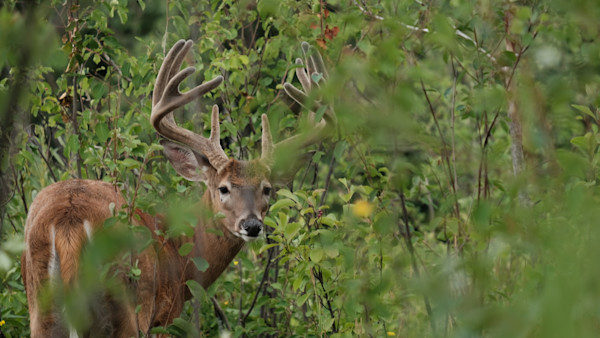
In the grand scheme of things, bedding areas are small. Usually, you're working with one or two core locations, and often not more than a handful of acres in size and sometimes it's as small as your living room. So it's important to maximize the overall use and effectiveness of these areas. The more diversity you can provide within them, the more attractive they are. When strategizing how to make bedding areas better, it's about balancing the right cover and the right vegetation to hold deer comfortably during daylight.
Think carefully about the location regardless of what type of bedding area you're setting out to improve. Ideally, you're working with an area where deer are either already bedding or are proximal to. But don't be afraid to improve or even establish a new bedding area that is more beneficial for the deer and your hunting strategy. No matter what techniques you're employing, think about what the whole property offers. Look for things like south-facing slopes in timber where sunlight will keep deer warm in winter months, gradually sloped ridges that fall away into creek bottoms that offer various wind advantages, or isolated, thick CRP and fallow fields that deer just seem to appear from. These features have natural drawing power for holding deer during daylight hours.
Establishing Horizontal Cover Deer love diversity and edge. Horizontal cover is a great way to achieve both thicker ground structure for more enticing bedding and more predictable travel. Hinge cutting trees has quickly become one of the most popular habitat management practices in the last decade. It's far from the end-all-be-all, but hinge cutting certainly has its place in improving bedding. When making cuts, the key is to leave enough meat and cambium layer for the tree to survive for multiple seasons and continue producing foliage for both added cover and food. Dropping these trees and opening the canopy lets more sunlight reach the forest floor. This dramatically helps encourage younger vegetation to flourish, creating little hot spots of highly nutritional food within the bedding areas.
When managing any habitat for deer, it's important to remember that they live in the area’s bottom five feet. Tall trees and park-like settings are nice to look at, but they’re essentially useless habitat from a deer's perspective. Bringing vegetation and structure down to head level and in reach for deer can be the difference between bedding areas being deer magnets or ghost towns.
Be strategic with the placement of the trees. Hinging trees in clusters creates attractive, specific bedding locations within the bedding area. Once you've established the desired locations and quantity of these clusters, think about how the deer will most likely navigate to them with different wind directions. Deer like to take the path of least resistance. You can create steering trails that deer will adapt to over time by hinging other trees. You can also feather edges along bedding areas leading in and out in the right locations that help steer the travel in places that work to your advantage.
Cover and Food in One Thick, nasty CRP and overgrown, old fields are some of my favorite bedding habitats to hunt in and around. They can also be some of the most attractive bedding areas for big bucks. A common issue is that these overgrown areas are often underutilized and undermanaged. With the right approach, you can make these areas more attractive and beneficial from both cover and food perspectives. Structure usually isn't the issue. Deer can hunker down and hide in just about any thick vegetation over four feet high. The concern lies at ground level with the forage.
Most grasses, especially cool season grasses, are virtually useless to deer. Unfortunately, these invasives can take over these unmanaged areas. It's important to get these on a burn schedule every few years. Small, woody browse, seedlings, and native forbs are nutrient-rich and often make up the majority of a deer's diet. The goal in these bedding areas is to strategically encourage the growth and regeneration of this early succession with prescribed fire. The fire resets the seedbed and allows for regrowth of young, nutrient-rich plants. It's incredible how quickly the regrowth will come back. In a matter of months, the area often regenerates thicker and healthier than it was before.
If the area is more than a few acres big, consider burning it in stages. This strategy will draw deer to different sections at different times of the year without completely resetting the bedding area all at once. Deer can utilize certain portions of the plot while the new, post-burn growth is establishing in others. You can also predict which sections of the bedding area will likely be the most attractive during hunting season after burning earlier in the year.








Conversation